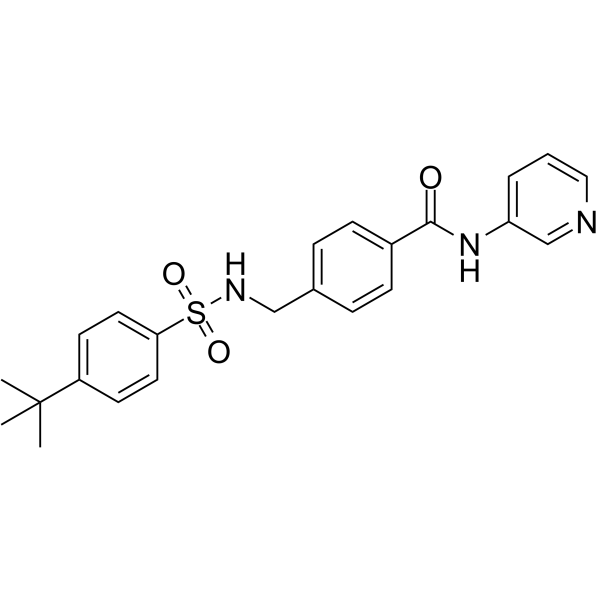上海金畔生物科技有限公司为生命科学和医药研发人员提供生物活性分子抑制剂、激动剂、特异性抑制剂、化合物库、重组蛋白,专注于信号通路和疾病研究领域。
STF-31 纯度: 96.97%
STF-31 是一种葡萄糖转运蛋白 1(GLUT1) 的选择性抑制剂, IC50 为 1 μM。

STF-31 Chemical Structure
CAS No. : 724741-75-7
| 规格 | 价格 | 是否有货 | 数量 |
|---|---|---|---|
| 10 mM * 1 mL in DMSO | ¥1210 | In-stock | |
| 10 mg | ¥1100 | In-stock | |
| 50 mg | ¥4400 | In-stock | |
| 100 mg | 询价 | ||
| 200 mg | 询价 |
* Please select Quantity before adding items.
STF-31 相关产品
•相关化合物库:
- Bioactive Compound Library Plus
- Membrane Transporter/Ion Channel Compound Library
- Anti-Cancer Compound Library
- Autophagy Compound Library
- Glycolysis Compound Library
- Glutamine Metabolism Compound Library
- Anti-Cancer Metabolism Compound Library
- Glucose Metabolism Compound Library
- Targeted Diversity Library
| 生物活性 |
STF-31 is a selective inhibitor of glucose transporter 1 (GLUT1), with an IC50 of 1μM[1][2]. |
||||||||||||||||
|---|---|---|---|---|---|---|---|---|---|---|---|---|---|---|---|---|---|
| IC50 & Target[2] |
|
||||||||||||||||
| 体外研究 (In Vitro) |
STF-31 (0.01-10 μM; 10 days) is specifically toxic to RCC4 cells, whereas RCC4/VHL cells are relatively unaffected. RCC4/VHL cells treated with STF-31 (5 μM; 10 days) largely recovery, whereas RCC4 cells under the same conditions does not[1]. 上海金畔生物科技有限公司 has not independently confirmed the accuracy of these methods. They are for reference only. Cell Viability Assay[1]
|
||||||||||||||||
| 体内研究 (In Vivo) |
Soluble analog of STF-31 (11.6 mg/kg; i.p.) treatment delays tumor growth in mice with VHL-deficient RCC tumor xenografts[1]. 上海金畔生物科技有限公司 has not independently confirmed the accuracy of these methods. They are for reference only.
|
||||||||||||||||
| 分子量 |
423.53 |
||||||||||||||||
| Formula |
C23H25N3O3S |
||||||||||||||||
| CAS 号 |
724741-75-7 |
||||||||||||||||
| 运输条件 |
Room temperature in continental US; may vary elsewhere. |
||||||||||||||||
| 储存方式 |
|
||||||||||||||||
| 溶解性数据 |
In Vitro:
DMSO : ≥ 34 mg/mL (80.28 mM) * “≥” means soluble, but saturation unknown. 配制储备液
*
请根据产品在不同溶剂中的溶解度选择合适的溶剂配制储备液;一旦配成溶液,请分装保存,避免反复冻融造成的产品失效。 In Vivo:
请根据您的实验动物和给药方式选择适当的溶解方案。以下溶解方案都请先按照 In Vitro 方式配制澄清的储备液,再依次添加助溶剂: ——为保证实验结果的可靠性,澄清的储备液可以根据储存条件,适当保存;体内实验的工作液,建议您现用现配,当天使用; 以下溶剂前显示的百
|
||||||||||||||||
| 参考文献 |
|
所有产品仅用作科学研究或药证申报,我们不为任何个人用途提供产品和服务
